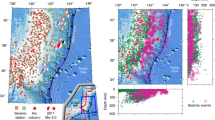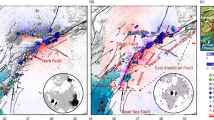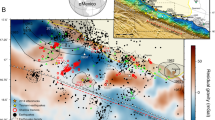Abstract
On 26 December 2004, a moment magnitude Mw = 9.3 earthquake occurred along Northern Sumatra, the Nicobar and Andaman islands, resulting in a devastating tsunami in the Indian Ocean region1. The rapid and accurate estimation of the rupture length and direction of such tsunami-generating earthquakes is crucial for constraining both tsunami wave-height models as well as the seismic moment of the events. Compressional seismic waves generated at the hypocentre of the Sumatra earthquake arrived after about 12 min at the broadband seismic stations of the German Regional Seismic Network (GRSN)2,3, located approximately 9,000 km from the event. Here we present a modification of a standard array-seismological approach and show that it is possible to track the propagating rupture front of the Sumatra earthquake over a total rupture length of 1,150 km. We estimate the average rupture speed to be 2.3–2.7 km s-1 and the total duration of rupture to be at least 430 s, and probably between 480 and 500 s.
This is a preview of subscription content, access via your institution
Access options
Subscribe to this journal
Receive 51 print issues and online access
$199.00 per year
only $3.90 per issue
Buy this article
- Purchase on Springer Link
- Instant access to full article PDF
Prices may be subject to local taxes which are calculated during checkout



Similar content being viewed by others
References
2004 Indian Ocean earthquake. In Wikipediahttp://en.wikipedia.org/wiki/2004_indian_ocean_earthquake (2005).
Ten Years of German Regional Seismic Network (GRSN). Report 25 of the Senate Commission for Geosciences of the Deutsche Forschungsgemeinschaft. (Wiley, Weinheim, 2002).
Krüger, F. & Stammler, K. The German Regional Seismic Network used as a longperiod array. Cahiers Centre Eur. Géodyn. Séismol. 12, 251–260 (1996)
Ni, S., Kanamori, H. & Helmberger, D. Energy radiation from the Sumatra earthquake. Nature 434, 582 (2005)
Schweitzer, J., Fyen, J., Mykkeltveit, S. & Kvaerna, T. in IASPEI New Manual of Seismological Observatory Practice (ed. Bormann, P.) Vol. 1, Ch. 9, 1–52 (GeoForschungsZentrum Potsdam, Potsdam, 2002)
Spudich, P. & Cranswick, E. Direct observation of rupture propagation during the 1979 Imperial Valley, California, earthquake using a short baseline accelerometer array. Bull. Seismol. Soc. Am. 74, 2083–2114 (1984)
Goldstein, P. & Archuleta, R. J. Deterministic frequency-wavenumber methods and direct measurement of rupture during earthquakes using a dense array—data analysis. J. Geophys. Res. 96, 6187–6198 (1991)
Huang, B. S. Evidence for azimuthal and temporal variations of the rupture propagation of the 1999 Chi-Chi, Taiwan earthquake from dense seismic array observations. Geophys. Res. Lett. 28, 3377–3380 (2001)
Kennett, B. L. N., Engdahl, E. R. & Buland, R. Constraints on seismic velocities in the Earth from travel times. Geophys. J. Int. 122, 108–124 (1995)
US Department of the Interior. US Geological Survey, Earthquake Hazards Program. Earthquake Report: Off W Coast of Northern Sumatrahttp://neic.usgs.gov/neis/eq_depot/2004/eq_041226/ (2005).
Yamanaka, Y. 04/12/26 off W. Coast of N. Sumatrahttp://www.eri.u-tokyo.ac.jp/sanchu/Seismo_Note/2004/EIC161ea.html (2005).
Stein, S. & Okal, E. A. Speed and size of the Sumatra earthquake. Nature 434, 581–582 (2005)
Lomax, A. Rapid estimation of faulting extent for large earthquakes by locating the end of rupture: application to the 2004, Mw = 9.0 South Asia mega-thrust. Geophys. Res. Abstr. 7, EGU05-A-02543 (2005); http://alomax.free.fr/posters/sasia/end_rupture/end_rupture.html.
Acknowledgements
We thank the German seismological central observatory (SZGRF) for supplying the data.
Author information
Authors and Affiliations
Corresponding author
Ethics declarations
Competing interests
Reprints and permissions information is available at npg.nature.com/reprintsandpermissions. The authors declare no competing financial interests.
Supplementary information
Supplementary Figure S1
This shows the stacked energy contribution of all 19 high-gain broadband records at GRSN in slowness and backazimuth for a time window containing direct P and PP phase. (PDF 142 kb)
Rights and permissions
About this article
Cite this article
Krüger, F., Ohrnberger, M. Tracking the rupture of the Mw = 9.3 Sumatra earthquake over 1,150 km at teleseismic distance. Nature 435, 937–939 (2005). https://doi.org/10.1038/nature03696
Received:
Accepted:
Issue Date:
DOI: https://doi.org/10.1038/nature03696
This article is cited by
-
Early Report of the Source Characteristics, Ground Motions, and Casualty Estimates of the 2023 Mw 7.8 and 7.5 Turkey Earthquakes
Journal of Earth Science (2023)
-
Stress, rigidity and sediment strength control megathrust earthquake and tsunami dynamics
Nature Geoscience (2022)
-
Imaging of rupture process of 2005 Mw 7.6 Kashmir earthquake using back projection techniques
Arabian Journal of Geosciences (2022)
-
Foreland Basin Geometry and Disposition of Major Thrust Faults as Proxies for Identification of Segmentation along the Himalayan Arc
Journal of the Geological Society of India (2022)
-
Estimating Seismic Intensity Maps of the 2021 Mw 7.3 Madoi, Qinghai and Mw 6.1 Yangbi, Yunnan, China Earthquakes
Journal of Earth Science (2022)
Comments
By submitting a comment you agree to abide by our Terms and Community Guidelines. If you find something abusive or that does not comply with our terms or guidelines please flag it as inappropriate.



